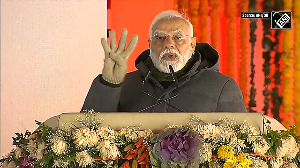September 1999. Nirmala Sankaran and Harsh Rajan were just two bankers in London. British newspapers at the time were full of reports about a shortage of mathematics teachers in the UK and US. There were also reports about India making huge strides in IT.
The reports made the bankers wonder, 'What if we were to combine technology and good methodology to teach maths? Then, if this were made accessible to anyone, we could solve the shortage of maths teachers!'
That is what they did.
 Nirmala and Harsh found there were different academic systems for mathematics in the world, along with different problems. For example, the UK had excellent teaching methodology, but a shortage of teachers. In India, teachers were plentiful but there was little creativity, so children feared the subject.
Nirmala and Harsh found there were different academic systems for mathematics in the world, along with different problems. For example, the UK had excellent teaching methodology, but a shortage of teachers. In India, teachers were plentiful but there was little creativity, so children feared the subject.
Coupled with their love for mathematics, it was the ability to sense a good business opportunity that made the husband and wife team approach the University of Cambridge for a collaborative effort. A lot of research on mathematics, mainly on how the Internet and technology could be used to better the teaching and learning process, was taking place. "They found we were serious and passionate about what we wanted to do. We also told them of our desire to build on the model they already had."
In June 2000, the couple quit their well-paying jobs to start their dream project, which was "more like doing the bungee jump".
And HeyMath! was born, in partnership with the Millennium Mathematics Project at Cambridge University.
"We wanted the name to be non-threatening and informal from a student's perspective. Instead of running away from the subject, we want students to address it like a friend. We used the word Math not because it's American usage but only because it was more phonetic," they explain.
They then moved to India, more precisely to Chennai, and created an R&D Maths lab with about 50 people. "We wanted our lab to continuously look for good practices in teaching and assessment matching various curricula around the world. We wanted this to be accessible to teachers and students, 24 hours a day. We found gaps in various systems, and realised we could make a fundamental change by providing solutions to fill those gaps." That was their aim.
They presented recruits with maths textbooks from India and the UK, along with teaching methods in the UK, to familiarise the team with the curriculum. Representatives from the Millennium Mathematics Project also came down to Chennai to train the HeyMath! team. The decision to use animation to solve maths problems was a combined one. "They (Cambridge) had done a lot of research on how technology could be effectively used to make children visualise and bring in real-life connectivity. We made it operational," says Nirmala.
There were discussions on each concept, which continued until someone came up with the idea of animating and connecting each theorem with real life.
December 2001. Once a databank of 100 lessons was ready, they knew they were ready to meet schools. They chose Singapore, to test the idea. "They are good adaptors and strong users of technology. Singapore looks for new and creative ideas in teaching, and prides itself for innovations in the academic system. So, we decided to first work with a country that was extremely advanced."
Cambridge University introduced HeyMath! to some of the top schools in Singapore. Soon, it was working with the biggest, Raffles Institutions, as well as the smaller Bedok Town secondary school. If Raffles wanted to use it "to try and improve student performance", Bedok Town wanted to use it for a completely different reason -- to motivate students to learn mathematics.
'So, the same system was used with two dramatically different purposes in mind. The fact that both schools continue to use HeyMath! says it was useful. It's our fourth year with them," says Harsh, proudly.
HeyMath! material is accompanied by animated lessons that member students can do on their own, online. Teachers can  teach using the material, and can also ask students to do homework and tests present online. Student users can log in from anywhere. The site answers their queries, clears doubts and helps them understand concepts better; just like a friend. For this, HeyMath! charges schools based on the number of student users.
teach using the material, and can also ask students to do homework and tests present online. Student users can log in from anywhere. The site answers their queries, clears doubts and helps them understand concepts better; just like a friend. For this, HeyMath! charges schools based on the number of student users.
The comments posted at the site speak for themselves. Julian Tay of Secondary 2, Raffles Institutions, says: 'I can understood topics better, especially trigonometry and geometry, through the well-designed flash animation.' Another comment comes from Kia Boon Noy of the same school: 'Very easy to understand mainly because of the animated graphics and step-by-step teaching.'
October 2005. HeyMath! now works with 25 per cent of all secondary schools (35 of 165 schools) in Singapore, as an extension of their maths departments.
After its success there, HeyMath! customised the entire CBSE and ICSE mathematics syllabus for India.
One of Chennai's premier schools following the CBSE syllabus, the Padma Seshadri Bala Bhavan, became a user in 2004. Around 2,500 of its students, from Standard 6 to Standard 10, take the help of HeyMath!
According to the team, "The difference between India and Singapore is that infrastructure in Indian schools is not as advanced. But many schools with a computer lab and Internet connection are getting in touch with us."
With Thomas Friedman writing about HeyMath! in his book The World is Flat and a column in The New York Times a month ago, several schools in the US are showing tremendous interest.
"There is a serious crisis in the US as far as schools are concerned," says Nirmala. "They are not sure if their curriculum is good enough. As for students, their capacity is not utilised at all, and this is particularly true of NRI parents in the US. A lot of people have written to us saying their children are in class 4 but are actually capable of doing class 7 material. They realise this when they come to India and look at what Indian children are doing."
With students from Singapore topping the TIMSS (Trends in Mathematics and Science Study) examination, many countries are looking at it as a model for maths and science education. In fact, apart from the US, HeyMath! now gets enquiries from 75 different countries.
What they want to do, eventually is this: "We want to be to maths what Google is to the Internet. We want to be the best maths teachers in the world." They're getting there alright.
Photographs: Sreeram Selvaraj






 © 2025
© 2025